CES 2006 Unveiled - Sneak Preview
By Chris Boylan
A Little of This, A Little of That
Here we are once again, in Sin City for the biggest baddest consumer electronics extravaganza of the year. The show officially opens Thursday (January 5) but members of the press are given sneak previews so I'm including a few items and announcements that caught my eye.
Last year's show was so enormous (reportedly over 140,000 attendees) that the CES folks decided to expand to even more venues this year, annexing The Sands Expo and Convention Center which had previously been the exclusive purview of the AVN Awards and Expo (aka "the porn show"). The "CES Unveiled" press preview kicked off on Tuesday evening with narry a porn star in sight (I was told to come back Saturday for that).
And the attendance isn't the only thing that has increased. The price of admission to the fabulous Las Vegas monorail is now up to a whopping $5 a ride (discounted to $35 for a 10 ride pass) - the entire length of the track being 4 miles. When compared to the New York City subway system, where you can ride on over 650 miles of track for $2, this doesn't really stand out as the transportation bargain of the century. But it beats sitting in a cab with the meter running, particularly in the snarl that is CES. And the Las Vegas shuttle's robotic drivers rarely go on strike.
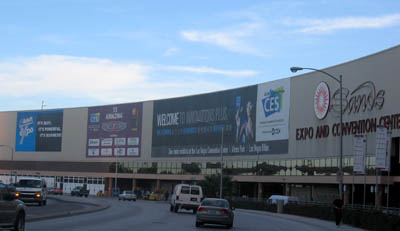
The Sands Expo became one of the primary venues for CES in 2006.
And now back to our regularly scheduled show report. At "CES Unveiled," we were treated by Verizon to an opening volley of technological jokes and celebrity impersonations by none other than Saturday Night Live alum Dana Carvey. Dana didn't have it easy, struggling to be heard over the murmuring mass of reporters and exhibitors but he took it in stride and those of us near the front were treated to a fine (albeit brief) show.
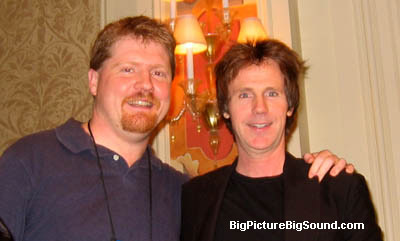
Our intrepid writer strikes a pose with Dana Carvey
After Carvey's routine, we learned that
DIVX (every downloader's favorite audio/video codec) signed a content distribution deal with Imagine, a smaller film label who mostly make documentaries. So you'll soon be able to download Imagine's film archive online, for a fee, encoded in the highly efficient DIVX codec. Apparently larger content deals are in discussion and may or may not be announced later in the week. Documentaries are nice, but I want my "Lord of the Rings" for download in HDTV quality. I'll wait...
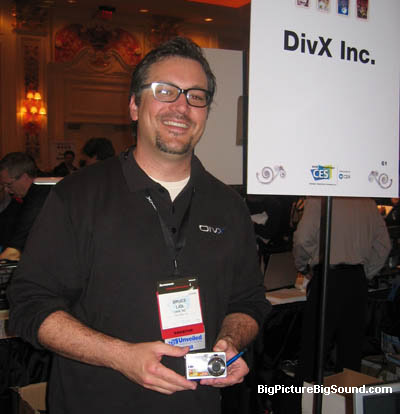
Bruce Lidl of DIVX poses with the Pentax Optio S6.
DiVX was also showing off a couple of new products that incorporate their codec technology. The Philips DVP5140 DVD player is the first "DIVX Ultra" certified home component, which means it can play back DIVX Ultra content. DIVX Ultra goes beyond the traditional codec by including support for graphical menus. These allow the viewer to navigate through audio and video content on a disc, flash memory or hard-drive. Think of DIVX Ultra as a DVD-like menu, without the DVD itself. Since DIVX is format-agnostic, DIVX ultra content can be distributed online, or via any convenient storage device like a USB thumbdrive or flash memory card. This technology is key in being able to deliver movies and other video content on demand via download, because it gives the end user a similar experience to what they already get with DVD.
The other device the DIVX folks were showing off was the Pentax Optio S6 digital camera which incorporates the DIVX codec so it can store a full 45 minutes of high quality (640X480) video on a 1GB SD memory card. This resolution of video capture is nearly unheard of on a compact digital still camera and the 45 minute record time on a 1 GB card is testament to the efficiency of the DIVX codec. Very impressive stuff.
Next door to DIVX was "This Is Cable" a cable trade organization formed to educate consumers on the benefits of digital cable. Peter Stern of
Time Warner was on-hand showing off their new "Start Over" feature which has been deployed in a few of their regional markets at no additional fee to the consumer. Start Over is similar to Tivo or PVRs in that it allows users to skip back to the start of a show while it's still playing live. But it's different than those other technologies because it does NOT require you to be taping or watching the channel when you decide to "start over" and it does not require a PVR-enabled cable box.
Let's say you're channel surfing and notice that a movie is on that you really wanted to see. Hit the "Start Over" button and the show returns to the beginning allowing you to see what you missed, even if you just turned the cable box on and you weren't taping anything. Unfortunately you cannot skip through commercials, but you can pause the program while watching it for bathroom or snack breaks or a phone call. Time Warner does this by "buffering" or recording all of their broadcast channels on a massive server farm with many terabytes of storage. Shows from all channels are recorded and kept for up to 2 1/2 times the length of the recorded program (e.g., half-hour shows are buffered for a total of 75 minutes), and when a viewer hits "Start Over" that show is delivered to him or her on-demand and they have a fixed but generous time window in which to watch the complete show.
I asked Peter (from Time Warner) if he has this feature himself. But he doesn't. In fact, we doesn't even have Time Warner cable. He has
Comcast and he's very happy with it. Sshhh, don't tell his bosses. Speaking of Comcast, they are apparently starting to hit heavy with High Definition on Demand (HDOD). 80 percent of their current customers have some High Definition content available on demand, classic films like "Close Encounter of the Third Kind" and "The Fifth Element." Comcast expects all of their customers to have HD on demand by March of this year, and is expanding their HDOD inventory quickly.
And High Def movies aren't the only things available on demand. They also create unique content like sports highlights from the previous night's football game, with actual NFL commentators, which can be ordered up the next day so you can still hold a meaningful conversation around the water cooler at work even if you missed the game. Comcast even has "Karaoke on Demand" for those who drink too much at holiday parties and think they can carry a tune. They currently have over 300 songs available and are building this library up as they acquire the rights to more tunes. I'd like to see them try THAT on DIRECTV!
Also getting into the television market in a big way is phone giant
Verizon. They are now beginning to offer "FIOS TV" services over fiberoptic lines in several markets in Texas, Florida and Virginia and are ramping up to begin offering the service in thirteen other states over the coming months. Their current line-up features over 330 digital channels including 20 High Definition channels. Verizon just signed an exclusive distribution deal with Disney so they'll soon be able to deliver unique Disney content that subscribers of traditional cable or satellite television will not have access to. FIOS TV's video-on-demand and program guides are delivered over Verizon's high-speed fiberoptic data network via IPTV for greatest efficiency and throughput. Current pricing is $39.99/month for the basic package.
Nearby,
Cyberhome, makers of affordable DVD players and recorders were showing off their new PMP7000 ($399) - a 7-inch widescreen portable video and audio player with a built-in 20 GB hard drive. It's DIVX certified and supports all of the popular audio and video codecs. Plus it supports a USB port, so you can pop in an external card reader or thumb drive and watch movies or shows from there. The coolest feature? Native support for 720p or 1080i content. So if you happen to have any DIVX AVI files encoded with High Definition resolution, you can play these on the Cyberhome player plugged directly into your big screen HDTV, or take them on the road and watch them on the built-in seven inch screen.
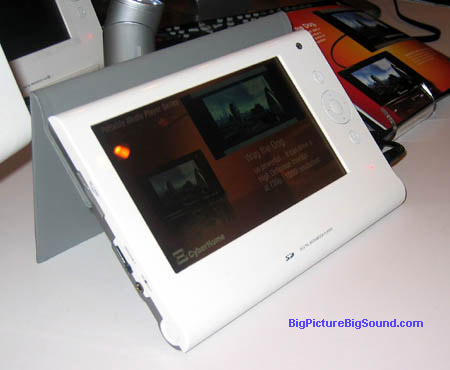
Cyberhome's PMP700 portable media player features native 1080i HD output.
And if you're looking for an even more portable video monitor, then consider
eMagin's new wearable video monitor. Based on similar technology to their z800 3D goggles, the new "eye-Bud 800" takes the video output of, say, an iPod (or other portable player or laptop computer) and displays it on a high resolution OLED video panel that sits in front of one eye, leaving your other eye free to stare off mindlessly into space. The virtual image size is equivalent to a 105 inch diagonal screen viewed at 12 feet. Pricing is yet to be finalized, but is not expected to be over $599.
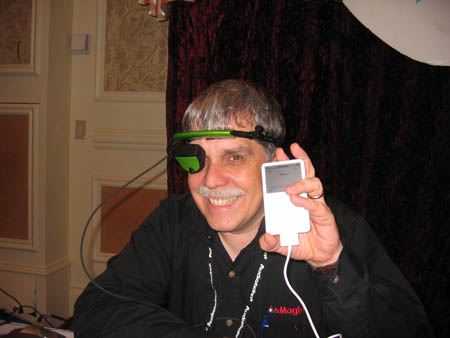
You will be assimilated... if you wear eMagin's EyeBud portable eyeware.
For larger screens,
Kaleidescape was also on hand showing off their newly enlarged 1.5 terabyte media storage/distribution system (which has been reduced to $22,000 MSRP for the entry-level system). The Kaleidescape system allows you to rip your entire DVD collection to the server, download the cover art, plot summaries and cast/crew information automatically via the internet, and then access and visually browse your movie collection from anywhere in your home (or your yacht or private jet, which are apparently popular places to install the Kaleidescape system). The base system, with 1.5 terabytes, can store up to 150 average-sized DVDs.
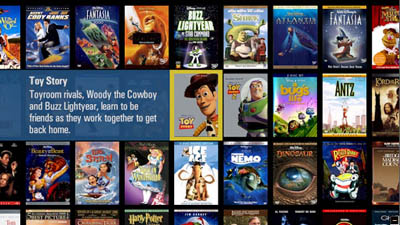
Kaleidescape enables you to interact with your movie collection in ways previously not possible.
Kaleidescape is also preparing to announce new music serving functionality that will allow you to search, browse and listen to your music collection the same way. As we mentioned in our Home Entertainment 2005 Show Report, the Kaleidescape system is extremely intuitive and easy to navigate. You can select a movie by searching on the actors or director, alphabetically, or by genre, or just flip through the DVD cover art on the screen. Once you select a particular film, the menu then rearranges itself to show other films that are similar to the one you've selected, thereby suggesting other films you might also like to watch.
Logitech was showing off their brand new Harmony Model 890 remote for consumers. Similar to the 890 Pro which was announced at CEDIA, the consumer version of the Harmony 890 takes all the good things about the model 880 (which we really liked) and adds RF functionality so you can now control systems in any room, or systems that are behind opaque doors. The model 890 will retail for $399 including the RF receiver and is expected to ship later this month. If you haven't heard anything about the Harmony internet-powered remotes, then check out our in-depth reviews of the
model 688 or
model 880.
Well that's it for "CES Unveiled." To find out what was announced on press day at CES see Part II of our coverage which includes
Sony's Book Reader and Blu-Ray Disc player, Toshiba and RCA's HD-DVD players, DTS-HD Master Audio multi-channel audio format, SlingMedia's SlingPlayer Mobile and more.





